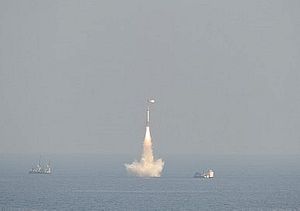India’s Defense Research & Development Organization (DRDO) will test-launch the indigenously-developed, nuclear capable K-4 ballistic missile from a submerged platform in the Bay of Bengal this week, The New India Express reports.
The K-4, an intermediate-range nuclear-capable submarine-launched ballistic missile with a purported range of up to 3,500 kilometers (2,174 miles), will be launched from a submerged pontoon, a replica of a submarine, from water 9 meters (around 30 feet) deep, according to DRDO sources.
The DRDO scientists’ purported aim this week is to test the full operational range of the missile. During a previous test in March 2014, where the weapon was ejected from the submerged pontoon by a powerful gas generator, the K-4 was only tested to a range of 3,000 kilometers (1,864 miles).
Technical details on the top-secret K-4 remain scarce. It purportedly is 12 meters (39 feet) long, weighs around 17 tons, can carry a nuclear capable warhead of up to 2 tons, and is powered by solid rocket propellants.
DRDO scientists claim that the missile is highly accurate with a near zero circular error probability. According to publicly available information, the K-4 uses a Ringer Laser Gyro Inertial navigation system.
The missile, capable of cruising at hypersonic speed, also features an “innovative” system of weaving in three dimensions during flight as it approaches its target. The New India Express paraphrases a DRDO scientist saying that this “exceptional feature of the weapon system makes it difficult to be tracked easily and destroyed by any anti-ballistic missile defense systems.”
The K-4 will undergo two more development tests before it will be fired from the Indian Navy’s first indigenously developed ballistic missile nuclear submarine (SSBN), the INS Arihant.
As I reported previously (See: “India’s Deadliest Sub Is Ready for Operations”), the INS Arihant is slated to be commissioned this month. The vessel is based on Russian Project 971 Akula I-class nuclear-powered attack submarine. It is the lead vessel of the Indian Navy’s future fleet of four Arihant-class SSBNs.
The submarine is equipped with four vertical launch tubes, which can be armed with either four K-4 missiles or 12—three per launch tube—K-15 missiles, another member of the K-series of missiles with a maximum range of 750 kilometers (466 miles).
There have also been some reports that DRDO is also working on a new top-secret variant of the K-4 with a 5,000 kilometer (3,106 miles) range.
India’s nuclear warfare policy is centered on a No First-Use (NFU) doctrine. The K family of missiles is meant to boost India’s second strike capability and will be the cornerstone of the sea leg of the country’s nuclear triad. India still maintains a policy of keeping its nuclear warheads de-mated from the missiles.
One of the major problems for India remains that its submarine force is too noisy, calling into question the credibility of its second-strike capability even with the new K-4 missile. Loud submarines are more easily detected and can be quickly neutralized in the event of war.

































